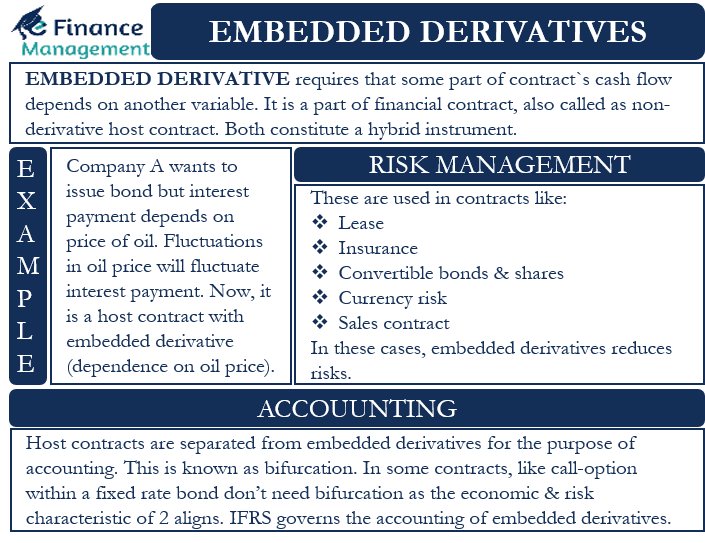A derivative is a financial instrument that gets its value from an underlying asset. An embedded derivative is similar to the usual derivative, with the only difference being in its placement. For instance, the usual derivatives are independent products that trade separately. However, embedded derivatives are part of a financial contract, which we can also call a non-derivative host contract.
The host contract and an embedded derivative together constitute a hybrid instrument. Or it is a combination of the non-derivative contract with a derivative feature.
Embedded Derivatives – What are They?
In simple words, we can say that embedded derivatives require that some part of the contract’s cash flow depends on another variable. This variable could be an interest rate, credit rating, currency exchange rate, commodity price, etc. IFRS 9 governs the specific requirements regarding the embedded derivatives.
Embedded derivatives change the host contract by making changes to the cash flow, which otherwise comes directly from the host contract. The lender takes up such a type of contact when they want some protection from future movement. For instance, in the case of a fixed-rate loan, there is a concern for a lender that he would lose if the interest rates go up. So, he can add a provision in the loan agreement to make interest payments dependent on another variable.
Example
Let’s take the example of embedded derivatives. Company A wants to issue a bond, but the payment of the interest is dependent on the price of oil. In this case, the payment would go up or down on the basis of oil price movement. Here, the debt security (bond) is the host contract with an embedded derivative (dependence of oil price).
A point to note is if it is possible to transfer a derivative separately, then it is generally not an embedded derivative. If we can separate a derivative from the host contract, then the derivative would come in the balance sheet at the fair value. Moreover, any changes in the fair value of the derivative should come under earnings for the current period.
Risk Management With Embedded Derivatives
People use embedded derivatives in several types of contacts, such as lease, insurance, and more. Even convertible bonds and shares can use such types of derivatives.
One can even use this type of derivative to guard against currency risk. For instance, a company makes manufacturing expenses in one currency while receiving revenues in another currency. This way, the company exposes itself to the currency rate risk.
To mitigate such risk, companies usually take the help of derivatives contracts like interest rate swaps, etc. However, companies can also use an embedded derivative for protection or for covering up such risks. The company can talk to the client and embed such risk in the sales contract. For example, in this case, a company can relate the revenue with the manufacturing cost.
This way, embedded derivatives make the contract less risky and take clients into confidence.

Accounting of Embedded Derivatives
When it comes to accounting for such derivatives, it is a complex task. However, the underlying concept is that one must show them at a fair value. The prudence and guidelines also suggest that if an embedded derivate can trade in the normal course as a usual derivative, then the host contract and embedded derivative both should be shown separately.
To ensure consistency, the focus is on making an accounting of embedded derivatives similar to traditional derivatives. So, it is important to separate it from the host contract. We call this process of separation as bifurcation.
Example
For example, one needs to separate the stock option by bifurcation for a convertible bond. Once separation happens, then the accounting of this embedded derivative, the stock option should be as usual, like a routine derivative. The accounting should be at a fair value. However, for the host contact, the accounting should be on a GAAP basis and consider the contract has no derivative.
In simple words, we can say that accounting of both the financial instruments (host contract and embedded derivative) should be done separately.
A point to note is that not all embedded derivatives contracts need bifurcation. Some contracts, like call-option within a fixed-rate bond, don’t need a separate accounting.
In fact, IFRS (International Financial Reporting Standards) has prescribed detailed guidelines and conditions wherein, in those specific cases, an embedded derivative needs to be separated from the host contract. One such criterion is when the economic characteristics and risks of both (host contract and embedded derivative) do not align closely or are at variance with each other.
For example, in the oil example above, the economic characteristics and risks of the two do not align, so we need to separate the two components.
Now, in the same example, assume the coupon and principal payment depends on the share price of Company A. In such a scenario, the economic and risk characteristics of the two align. Thus, we must not separate the two for accounting purposes.
It may not be easy to separate the contracts in some exceptional cases. In such cases, the IFRS requires the accounting of the full contract at fair value. Also, any changes in the fair value must come as current earnings.
Final Words
It won’t be wrong to say that the prime purpose of embedded derivatives is to transfer or cover some part of the risk. Making the cash flow dependent on a variable transfer the risk from one party to another. One party, usually the seller, gets the protection, and another party is exposed to risk. So, we can say that such derivatives encourage investors to invest in otherwise less appealing contracts by making them less risky.

